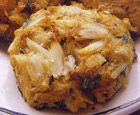|
Cajun-Creole Appetizer Creole Crab Cakes Delicious, sweet crab cakes with a little added zing.
Sauté celery and onion in 1 T of oil till soft. Add the garlic and stir for 2 minutes. Set skillet aside to cool. Combine mayonnaise, mustard, nutmeg and cayenne. Add the diced pepper(s), crabmeat, and breadcrumbs. Shape into 12 small patties. Sauté in the 3 T of oil till golden. Drain on a paper towels, and serve warm with a bitey dip of Dijon mustard and mayonnaise. (You can make the crab cakes ahead, chill, and then toast them up in the oven.) |
Tips & Glossary Creole cooking, centered around New Orleans, blends French, Spanish, and African cuisines. Its origin is pre-civil war and more aristocratic than Cajun cuisine. The word Cajun, associated with the Bayou backwaters of Louisiana, comes from "Acadian," French Canadians deported to the "Acadian" region of Louisiana. Cajun cuisine is simpler, spicier, and more countrified than its Creole cousin. • Blonde Roux (or Creole roux): used to thicken stews, especially Etouffee. Melt 1 part fat and gradually add 1 part flour. Stir constantly over medium-low heat till mixture is a light golden brown (10 minutes or so). • Brown Roux (or Cajun roux): used as a thickener for gumbo. Follow recipe for blond roux but continue stirring for a longer time, till you achieve a rich brown, mahogany color. Be careful not to burn it. • Cajun seasoning: a seasoned salt; buy it at most grocery stores or make your own in a blender: 3 T each of black pepper, cayenne, garlic powder, onion powder, chili powder, oregano, and 3 bay leaves. Add the ground spices to a standard 26 oz. box of salt. You can also add basil, nutmeg, paprika, or thyme. Experiment. • Chile Powder dried, ground hot chili peppers; an ingredient in chili powder (see below). • Chili Pepper: any small, hot pepper, as opposed to larger, milder bell peppers; includes, cayenne (red), chipotle (smoke-dried jalapeños), habanero, jalapeño, paprika, poblano, serrano, and tabasco. • Chili Powder: different from chile powder (see above); dried ground chili peppers typically mixed with cumin, garlic powder, and oregano. You can make your own blend with cinnamon, cloves, coriander, even nutmeg. Briefly heat dried peppers and spices in a skillet to release flavors, then grind them into powder. • Crabmeat: meat from body, legs or claws of numerous varieties of crab. Most prized is jumbo lump from the hind leg. But for crab cakes and casseroles, use regular lump, as well as finback from the body. Claw meat is brown and stronger flavored, though also good for crab recipes. Buy it fresh if you can. • File Powder: also called “gumbo powder”; a spice made from dried, ground sassafras leaves. Used as flavoring and thickener in Cajun cooking, especially gumbo. Holy Trinity: the combination of diced onions, bell peppers, and celery, which forms the basis of flavor in Cajun and Creole cooking, especially Gumbo, Jambolaya, and Etoufee.
|
Site by BOOM
![]()
LitLovers © 2024

